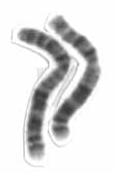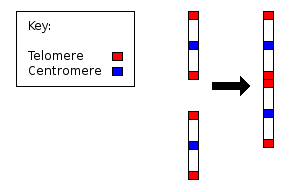Chromosome 2 (human)
| Chromosome 2 (human) | |
|---|---|
 Human chromosome 2 pair after G banding. One is from mother, one is from father. | |
 Chromosome 2 pair in human male karyogram. | |
| Features | |
| Length (bp) | 242,193,529 bp |
| Number of genes | 2,787 |
| Type | Autosome |
| Centromere position | Submetacentric[1] |
| Identifiers | |
| RefSeq | NC_000002 |
| GenBank | CM000664 |


Chromosome 2 is one of the 23 pairs of chromosomes in humans. People normally have two copies of this chromosome. Chromosome 2 is the second largest human chromosome, spanning more than 242 million base pairs [2] (the building material of DNA) and representing almost 8% of the total DNA in cells.
Identifying genes on each chromosome is an active area of genetic research. Because researchers use different approaches to predict the number of genes on each chromosome, the estimated number of genes varies. Chromosome 2 likely contains 1,491 genes, including those of the HOXD homeobox gene cluster.[3]
Evolution
All members of Hominidae except humans, Neanderthals, and Denisovans have 24 pairs of chromosomes.[4] Humans have only 23 pairs of chromosomes. Human chromosome 2 is a result of an end-to-end fusion of two ancestral chromosomes.[5][6]
The evidence for this includes:
- The correspondence of chromosome 2 to two ape chromosomes. The closest human relative, the chimpanzee, has near-identical DNA sequences to human chromosome 2, but they are found in two separate chromosomes. The same is true of the more distant gorilla and orangutan.[7][8]
- The presence of a vestigial centromere. Normally a chromosome has just one centromere, but in chromosome 2 there are remnants of a second centromere.[9]
- The presence of vestigial telomeres. These are normally found only at the ends of a chromosome, but in chromosome 2 there are additional telomere sequences in the middle.[10]
According to researcher J. W. IJdo, "We conclude that the locus cloned in cosmids c8.1 and c29B is the relic of an ancient telomere-telomere fusion and marks the point at which two ancestral ape chromosomes fused to give rise to human chromosome 2." [10]
Genes
Among the genes located on chromosome 2 are these:
- ACTR1B: encoding protein Beta-centractin
- ACTR2: encoding protein Actin-related protein 2
- ADI1: encoding enzyme 1,2-dihydroxy-3-keto-5-methylthiopentene dioxygenase
- AFF3: encoding protein AF4/FMR2 family member 3
- AFTPH: encoding protein Aftiphilin
- AGXT: alanine-glyoxylate aminotransferase (oxalosis I; hyperoxaluria I; glycolicaciduria; serine-pyruvate aminotransferase)
- ALS2: amyotrophic lateral sclerosis 2 (juvenile)
- ALS2CR8: encoding protein Amyotrophic lateral sclerosis 2 chromosomal region candidate gene 8 protein also known as calcium-response factor (CaRF)
- ARMC9: encoding protein LisH domain-containing protein ARMC9
- C2orf18: encoding protein Transmembrane protein C2orf18
- C2orf28: ecndoing protein Apoptosis-related protein 3
- COL3A1: collagen, type III, alpha 1 (Ehlers-Danlos syndrome type IV, autosomal dominant)
- COL4A3: collagen, type IV, alpha 3 (Goodpasture antigen)
- COL4A4: collagen, type IV, alpha 4
- COL5A2: collagen, type V, alpha 2
- CTLA4: cytotoxic T-Lymphocyte Antigen 4
- HADHA: hydroxyacyl-Coenzyme A dehydrogenase/3-ketoacyl-Coenzyme A thiolase/enoyl-Coenzyme A hydratase (trifunctional protein), alpha subunit
- HADHB: hydroxyacyl-Coenzyme A dehydrogenase/3-ketoacyl-Coenzyme A thiolase/enoyl-Coenzyme A hydratase (trifunctional protein), beta subunit
- NCL: Nucleolin
- NR4A2: nuclear receptor subfamily 4, group A, member 2
- OTOF: otoferlin
- PAX3: paired box gene 3 (Waardenburg syndrome 1)
- PAX8: paired box gene 8
- PELI1: Ubiquitin ligase
- RPL37A: encoding protein 60S ribosomal protein L37a
- SATB2: Homeobox 2
- SLC40A1: solute carrier family 40 (iron-regulated transporter), member 1
- SSB: Sjogren syndrome antigen B
- TPO: thyroid peroxidase
- TTN: titin
Genes located on the short arm of this chromosome include
- ALMS1
- ABCG5 and ABCG8: ATP-binding cassette, subfamily A, members 5 and 8
- MSH2: mutS homolog 2, colon cancer, nonpolyposis type 1 (E. coli)
- MSH6: mutS homolog 6 (E. coli)
- TTC7A: familial multiple intestinal atresia
- WDR35 (IFT121: TULP4): intraflagellar transport 121
Genes located on the long arm of this chromosome include
- ABCA12: ATP-binding cassette, sub-family A (ABC1), member 12
- BMPR2: bone morphogenetic protein receptor, type II (serine/threonine kinase)
- TBR1: T-box, brain, 1
Related diseases and traits
The following diseases and traits are related to genes located on chromosome 2:
- 2p15-16.1 microdeletion syndrome
- Autism
- Alport syndrome
- Alström syndrome
- Amyotrophic lateral sclerosis
- Amyotrophic lateral sclerosis, type 2
- Congenital hypothyroidism
- Crigler-Najjar types I/II
- Dementia with Lewy bodies
- Ehlers–Danlos syndrome
- Ehlers–Danlos syndrome, classical type
- Ehlers–Danlos syndrome, vascular type
- Fibrodysplasia ossificans progressiva
- Gilbert's Syndrome
- Harlequin type ichthyosis
- Hemochromatosis
- Hemochromatosis type 4
- Hereditary nonpolyposis colorectal cancer
- Infantile-onset ascending hereditary spastic paralysis
- Juvenile primary lateral sclerosis
- Long-chain 3-hydroxyacyl-coenzyme A dehydrogenase deficiency
- Maturity onset diabetes of the young type 6
- Mitochondrial trifunctional protein deficiency
- Nonsyndromic deafness
- Nonsyndromic deafness, autosomal recessive
- Primary hyperoxaluria
- Primary pulmonary hypertension
- Sitosterolemia (knockout of either ABCG5 or ABCG8)
- Sensenbrenner syndrome
- SATB2 Associated syndrome
- Synesthesia
- Waardenburg syndrome
References
- ↑ "Table 2.3: Human chromosome groups". Human Molecular Genetics (2nd ed.). Garland Science. 1999.
- ↑ Hillier; et al. (2005). "Generation and annotation of the DNAD sequences of human chromosomes 2 and 4". Nature. 434 (7034): 724–31. Bibcode:2005Natur.434..724H. doi:10.1038/nature03466. PMID 15815621.
- ↑ Vega Homo sapiens genome browser: HoxD cluster on Chromosome 2
- ↑ Meyer M, Kircher M, Gansauge MT, Li H, Racimo F, Mallick S, Schraiber JG, Jay F, Prüfer K, de Filippo C, Sudmant PH, Alkan C, Fu Q, Do R, Rohland N, Tandon A, Siebauer M, Green RE, Bryc K, Briggs AW, Stenzel U, Dabney J, Shendure J, Kitzman J, Hammer MF, Shunkov MV, Derevianko AP, Patterson N, Andrés AM, Eichler EE, Slatkin M, Reich D, Kelso J, Pääbo S; Kircher; Gansauge; Li; Racimo; Mallick; Schraiber; Jay; Prüfer; De Filippo; Sudmant; Alkan; Fu; Do; Rohland; Tandon; Siebauer; Green; Bryc; Briggs; Stenzel; Dabney; Shendure; Kitzman; Hammer; Shunkov; Derevianko; Patterson; Andrés; et al. (October 2012). "A high-coverage genome sequence from an archaic Denisovan individual". Science. 338 (6104): 222–6. Bibcode:2012Sci...338..222M. doi:10.1126/science.1224344. PMC 3617501
 . PMID 22936568.
. PMID 22936568. - ↑ It has been hypothesized that Human Chromosome 2 is a fusion of two ancestral chromosomes by Alec MacAndrew; accessed 18 May 2006.
- ↑ Evidence of Common Ancestry: Human Chromosome 2 (video) 2007
- ↑ Yunis and Prakash; Prakash, O (1982). "The origin of man: a chromosomal pictorial legacy". Science. 215 (4539): 1525–30. Bibcode:1982Sci...215.1525Y. doi:10.1126/science.7063861. PMID 7063861.
- ↑ Human and Ape Chromosomes; accessed 8 September 2007.
- ↑ Avarello; et al. (1992). "Evidence for an ancestral alphoid domain on the long arm of human chromosome 2". Human Genetics. 89 (2): 247–9. doi:10.1007/BF00217134. PMID 1587535.
- 1 2 IJdo; et al. (1991). "Origin of human chromosome 2: an ancestral telomere-telomere fusion". Proc. Natl. Acad. Sci. U.S.A. 88 (20): 9051–5. Bibcode:1991PNAS...88.9051I. doi:10.1073/pnas.88.20.9051. PMC 52649
 . PMID 1924367.
. PMID 1924367.
| Wikimedia Commons has media related to Human chromosome 2. |